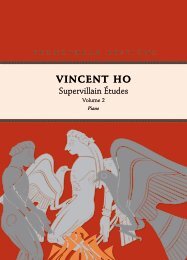The Mega4 Meta4
by Christos Hatzis | Viola and Digital Audio
by Christos Hatzis | Viola and Digital Audio
Create successful ePaper yourself
Turn your PDF publications into a flip-book with our unique Google optimized e-Paper software.
<strong>The</strong> <strong>Mega4</strong> <strong>Meta4</strong> was commissioned by violist Douglas Perry with a grant from<br />
the Ontario Arts Council. It is the fifth and final piece of Earthrise, a pentalogy of<br />
electroacoustic works. With the exception of the opening pentatonic theme, <strong>The</strong><br />
<strong>Mega4</strong> <strong>Meta4</strong> is constructed entirely from quoted material (mainly from the four<br />
earlier pieces of Earthrise and from Albinoni’s Adagio in G minor for Organ and<br />
Strings.) <strong>The</strong> quoted material is used as a starting point and, once stated, it is<br />
developed, repeated and juxtaposed on top of other, sometimes non-compatible<br />
material in such a way that the overall effect is that of dynamic pluralism and<br />
constant motion in opposite directions. <strong>The</strong> <strong>Mega4</strong> <strong>Meta4</strong> brings all the aesthetic<br />
and technical concerns of the earlier pieces to their logical conclusion. To a<br />
considerably greater extent than the other four works of Earthrise, it is a<br />
‘dependent’ composition; not so much because it is not musically and dramatically<br />
self-contained, but because the development of its thematic and motivic ideas<br />
assume particular significance when seen against the background of how these<br />
same ideas were treated in the previous pieces. As in the other pieces of Earthrise,<br />
the musical material plays equally significant roles on two different plains—the<br />
purely musical and the symbolic. Even during its most outwardly mundane<br />
moments, the music has an inner cryptic identity. <strong>The</strong> choice of cheap ‘street’<br />
material for example, and the conscious effort to realize the unexplored and often<br />
overlooked potential hidden within it, is to me, symbolically the musical analogue<br />
of the biblical quotation “the stone which was rejected by the architects has<br />
become a cornerstone.” <strong>The</strong> chronological and geographic eclecticism, the<br />
transcendental union of heterogeneous materials, and my entire ‘grass-roots’<br />
approach to composition, are outward manifestations of deeper religious and<br />
philosophical convictions about our world and our role in it. ‘Heavy’ as all this<br />
may sound, the music itself is anything but. Throughout Earthrise there is a sense<br />
of ‘lightness’ which permeates every aspect of the composition. Religious<br />
<br />
<br />
<br />
<br />
symbolism and humour exist side-by-side in a mutually exclusive, yet<br />
complementary partnership. <strong>The</strong> <strong>Mega4</strong> <strong>Meta4</strong> takes its name from my second<br />
computer, an Atari <strong>Mega4</strong> ST which I purchased a few days before embarking on<br />
the composition of the piece.<br />
In 2004 a new version of <strong>The</strong> <strong>Mega4</strong> <strong>Meta4</strong> for viola and orchestra was created<br />
under the title Rebirth at the request of Canadian violist Steven Dann and<br />
premiered by Steven at the Scotia Festival of Music 2007 in Halifax, Nova Scotia.<br />
<br />
Quickly bend the note upwards or downwards to the<br />
upper or lower neighbour note and immediately<br />
return to the original pitch.<br />
Gradual transformation between naturale and sul<br />
ponticello.<br />
Meno mosso, a tempo and piu mosso.


















